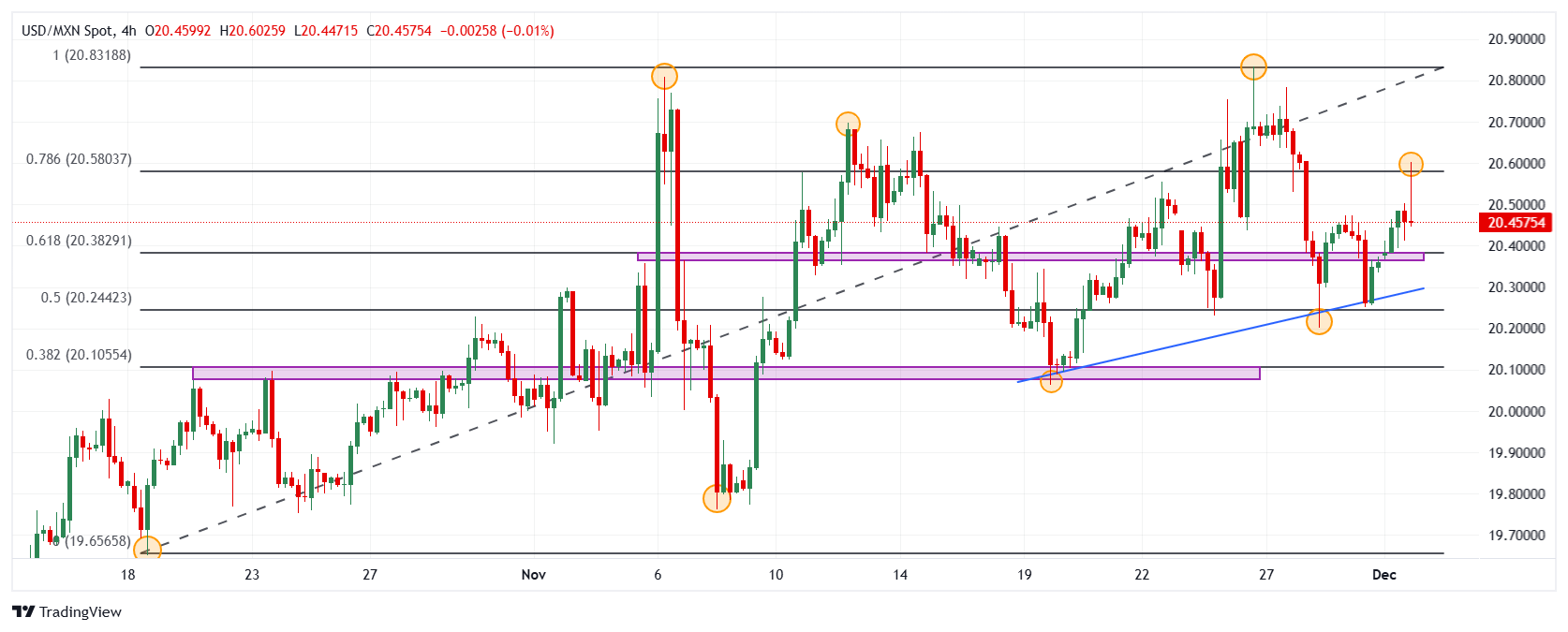- The USD/MXN rebounds 0.51% at the beginning of the week.
- The US ISM Manufacturing PMI came in at 48.4 in November, above market expectations.
- The INEGI will release Mexico’s unemployment rate on Tuesday, the consensus expects it to remain unchanged.
USD/MXN hit a daily low of 20.36, finding buyers who pushed the pair to a two-day high of 20.60. At the time of writing, the price of the US dollar is trading at 20.45 against the Mexican Peso, rising 0.51% daily.
The Mexican Peso loses traction after the US ISM Manufacturing PMI
According to information presented by the Institute of Supply Management (ISM), the Manufacturing PMI registered an increase to 48.4 in November from 46.5 registered in October, exceeding the 47.5 points estimated by analysts. After these figures, the USD/MXN has ended a streak of three consecutive downward sessions, reaching a maximum not seen since November 28 at 20.60.
Investors’ attention will be on employment data this week. The National Institute of Statistics and Geography (INEGI) will publish Mexico’s unemployment rate for October, which is expected to remain unchanged at 2.9%.
On the other hand, the ADP employment report for November will be released on Wednesday. Market projections estimate a decrease to 150,000 from the 233,000 recorded in October.
Technical levels in the USD/MXN
USD/MXN reacted lower from short-term resistance at 20.60, converging with the 78.6 Fibonacci retracement. We see the first support zone at 20.20, given by the minimum of November 28. The next key support area lies at 19.76, the November 7 pivot point.
USD/MXN 4-hour chart

The US Dollar FAQs
The United States Dollar (USD) is the official currency of the United States of America, and the “de facto” currency of a significant number of other countries where it is in circulation alongside local banknotes. According to 2022 data, it is the most traded currency in the world, with more than 88% of all global currency exchange operations, equivalent to an average of $6.6 trillion in daily transactions. After World War II, the USD took over from the pound sterling as the world’s reserve currency.
The single most important factor influencing the value of the US Dollar is monetary policy, which is determined by the Federal Reserve (Fed). The Fed has two mandates: achieve price stability (control inflation) and promote full employment. Your main tool to achieve these two objectives is to adjust interest rates. When prices rise too quickly and inflation exceeds the 2% target set by the Fed, the Fed raises rates, which favors the price of the dollar. When Inflation falls below 2% or the unemployment rate is too high, the Fed can lower interest rates, which weighs on the Dollar.
In extreme situations, the Federal Reserve can also print more dollars and enact quantitative easing (QE). QE is the process by which the Fed substantially increases the flow of credit into a clogged financial system. This is an unconventional policy measure used when credit has dried up because banks do not lend to each other (for fear of counterparty default). It is a last resort when a simple lowering of interest rates is unlikely to achieve the necessary result. It was the Fed’s weapon of choice to combat the credit crunch that occurred during the Great Financial Crisis of 2008. It involves the Fed printing more dollars and using them to buy US government bonds, primarily from financial institutions. QE usually leads to a weakening of the US Dollar.
Quantitative tightening (QT) is the reverse process by which the Federal Reserve stops purchasing bonds from financial institutions and does not reinvest the principal of maturing portfolio securities in new purchases. It is usually positive for the US dollar.
Source: Fx Street
I am Joshua Winder, a senior-level journalist and editor at World Stock Market. I specialize in covering news related to the stock market and economic trends. With more than 8 years of experience in this field, I have become an expert in financial reporting.







